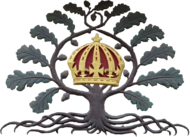Loyalism

Loyalism, in the
Historical loyalism
18th century
North America
In North America, the term loyalist characterised colonists who rejected the
British military strategy during the American Revolution relied on mobilising loyalist soldiers throughout the
After the war, approximately 80–90 per cent of the Loyalists stayed in the new United States, and adapted to the new conditions and changes of a republic.[citation needed]
Loyalist migrants
Of the 62,000 who left by 1784, almost 50,000 sought refuge elsewhere in the
These Loyalists were the founders of modern English-speaking Canada, and many of their descendants of these King's Loyal Americans still identify themselves with the nominal hereditary title "UEL" (United Empire Loyalist) today. To one degree or another, from ideological reasons or less so mixed with prospects of a better life, "All the Loyalists had taken a stand for the Crown and the British Empire"...whether "from a rigorous toryism to some vague sense that royal government was hardly so evil as its enemies claimed. In Canada this diversity was preserved. The Loyalist communities were rarely unanimous – or placid – in their politics".[12]
Ireland
The term loyalist was first used in Irish politics in the 1790s to refer to Protestant Irishmen (often of English or Scottish ancestry) who opposed
19th century
Australia
The Sydney and Parramatta Loyalist Associations, with approximately 50 members each, were formed in 1804 to counter radical societies in those counties, and subsequently helped to put down the Castle Hill convict rebellion later that year.[14][15]
England and Wales
| Part of the Politics series on |
| Toryism |
|---|
 |
During the early 19th century, nearly every English and Welsh county formed a Loyalist Association of Workers in an effort to counter a perceived threat from radical societies.[16] The first such association was founded in Westminster on 20 November 1792.[citation needed]
Modern loyalism
Northern Ireland
Generally, the term loyalist in Northern Ireland is typified by a militant opposition to Irish republicanism, and also often to Roman Catholicism. It stresses Ulster Protestant identity and community with its own folk heroes and events, such as the actions of the 36th (Ulster) Division during World War I and the activities of the Orange Order. An Ulster loyalist is most commonly a unionist who strongly favours the political union between Great Britain and Northern Ireland,[17] although some may also support an independent Northern Ireland.[18][19][20] In recent times, the term has been used to refer to several loyalist paramilitary groups, such as the Ulster Defence Association (UDA), Ulster Volunteer Force (UVF), Red Hand Commando (RHC) and the Loyalist Volunteer Force (LVF).
Although Irish loyalist paramilitaries have claimed to speak on behalf of their communities and unionists in general, their electoral support is minimal and exclusively based in the urban working class. The Progressive Unionist Party, a pro-Belfast Agreement loyalist party, won seats in the Northern Ireland Assembly in 1998, 2003 and 2007, but lost them in 2011.
Republic of Ireland
Loyalism in the post-partition Republic of Ireland has declined since independence.[21] Large numbers of southern Irish loyalists and non-loyalists volunteered for service in the British Armed Forces in World War I and World War II, many of them losing their lives or settling in the United Kingdom after the wars.[22] Partition saw mass movements of southern loyalists to Northern Ireland or to Great Britain,[23] although small loyalist or neo-unionist groups are still active.[citation needed]
Scotland
The Scottish loyalist movement originated during the
Coming from a large section of Scottish society Scottish loyalism has become more visible through prominent demonstrations of the beliefs of its members since the establishment of a
See also
- Conservative
- Legitimist
- Monarchism
- Reactionary
- Restoration (disambiguation)
- Royalist
Notes
- ^ St. John's Island was renamed Prince Edward Island in 1798.
References
- ^ Wallace Brown, "The Loyalists and the American Revolution." History Today (Mar 1962), 12# 3, pp. 149–157.
- ISBN 978-0-06-124180-2.
- ISBN 9780870570926.
- ^ Robert M. Calhoon (1973). The loyalists in Revolutionary America: 1760–1781. Harcourt Brace Jovanovich.
- ^ "Loyalist Institute: List of Loyalist Regiments". Retrieved 18 November 2011.
- ISBN 9780598865229.
- ^ "Loyalists in the Maritimes — Ward Chipman Muster Master's Office, 1777–1785". Library and Archives Canada. Government of Canada. 16 May 2019. Retrieved 3 May 2020.
- ^ Maya Jasanoff (2011). Liberty's Exiles, American Loyalists in the Revolutionary World. Alfred A. Knopf. pp. 206–208.
- ISBN 0-7710--6093-9
- ^ Murray Barkley (1975). Murray Barkley the Loyalist tradition in New Brunswick:: the growth and evolution of an historical myth, 1825–1914. s.n.
- ^ Acadiensis 4 (1975): 3–45;
- ^ Moore, op. cit. p, 253
- ^ a b Arthur Lyon Cross (1920). A shorter history of England and greater Britain. The Macmillan company. pp. 593–595, 597.
- ^ "The Military at Parramatta". Archived from the original on 26 September 2015. Retrieved 28 September 2008.
- ^ Keith Coleman; J. T. Knight (1953). Short history of the military forces in N.S.W. from 1788 to 1953.
- ISBN 978-0-19-926125-3.
- ^ White, Andrew (2007). "Is contemporary Ulster unionism in crisis? Changes in unionist identity during the Northern Ireland Peace Process. Irish Journal of Sociology". pp. 118–135.
- ^ Staff (2011). "Northern Ireland Loyalist Paramilitaries (U.K., extremists)". Council on Foreign Relations. Archived from the original on 20 June 2013. Retrieved 23 May 2012.
- ISBN 9780199875382.
- ^ "People - Political Science - Trinity College Dublin" (PDF). www.tcd.ie.
- ISBN 978-0-521-82009-7.
- ISBN 978-1-84725-008-7.
- ISBN 978-0-415-19880-6.
- ^ Niall O'Dochartaigh (2004–2005). "Support in Great Britain". A Guide to Ulster Loyalism and Unionism Online. CAIN Web Service. Retrieved 23 May 2012.
